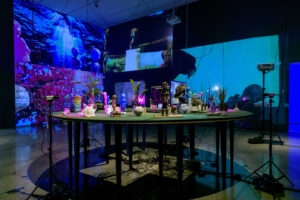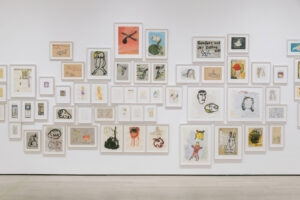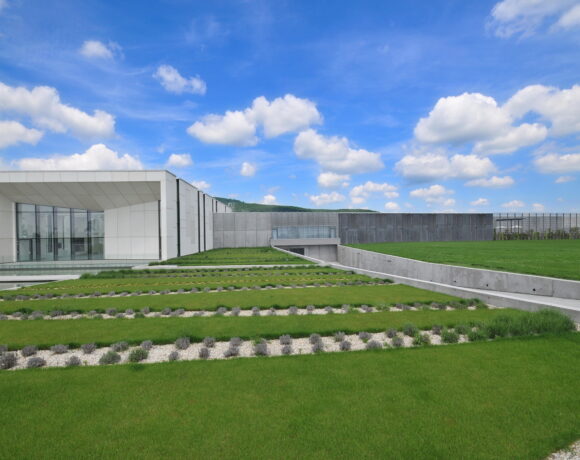LACMA, with a collection of 142,000 works of art spanning six thousand years of history from around the world, is the largest art museum in the Western United States. However, the space is never too much, and for this reason the museum is expanding the exhibition spaces with the addition of the David Geffen Galleries (in the memory of the patron David Geffen), designed by Peter Zumthor, and with an expected cost of 750 million dollars, almost entirely covered by donations and sponsorships. This project is nearing completion (opening is scheduled for 2024), yet to be honest the museum had already expanded with the addition of the Broad Contemporary Art Museum (2008) and the Resnick Exhibition Pavilion (2010), both designed by Renzo Piano. Obviously, these interventions are a way not only to confirm the legacy of over fifty years of LACMA history, but also to lay the roots of a future identity, well rooted in the territory and recognized by all of Los Angeles County.
Peter Zumthor’s project is based on the idea of creating an “emotional space”, and like the glass corridors of the Pompidou that run outside the exhibition walls and invite you to look at the Paris skyline, so, the glass walls designed by Zumthor not only invite museum visitors to look at the Los Angeles landscape and light but at the same time allow passers-by to peek inside. In this way inside and outside are confused on an indistinct level of emotions and involvement, a bit like in Mies van der Rohe’s horizontally developed architecture. This translucent diaphragm visually connects the interior galleries to everyday life on Wilshire Boulevard and the surrounding park, offering spectacular views of the surrounding landscape. The Zumthor project also adds a new and large open public space in order to create a cultural and social center that is even more accessible and open to the community.
For weeks due to the pandemic it was possible to admire only the outdoor installations, such as “Urban Light” by Chris Burden and “Levitated Mass” by Michael Heizer and access the green spaces of the garden. From today, 1 April, the temporary exhibitions in progress will also reopen to the public, which make us understand the truly ramified scope of the organizational work of the LACMA: “Golden Hour: California Photography from the Los Angeles County Museum of Art”; Bill Viola: Slowly Turning Narrative”; the one-man show dedicated to Yoshitomo Nara; Cauleen Smith’s “Give It Or Leave It” traveling exhibition; “Fiji: Art & Life in the Pacific”; “NOT I: Throwing Voices (1500 BCE-2020 CE)”.
Among the various proposals of the LACMA we focus on the Cauleen Smith solo show which had previously been exhibited at the Institute for Contemporary Art, Virginia Commonwealth University; Frye Art Museum; The Institute of Contemporary Art Pennsylvania. The project is curated by Anthony Elms, Daniel and Brett Sundheim and is organized at LACMA by Rita Gonzalez, Terri and Michael Smooke.
Cauleen Smith (born in Riverside, California, 1967, lives in Los Angeles) is a director and multimedia artist, best known for her experimental works that examine African-American identity, and in particular the problems facing women, who have to face every day within communities still marked by a very retrograde and far too restricted vision. Defining it with a terminology of the past, we should speak of an artist who is committed or who brings the primary problems of civil rights to art.
In the five video projections and nine installations created for this project (with multiple screens, objects scattered like in a playroom, projected images that overlap) you can find a sort of “mini inventory” of the most idealistic and dreamy creative personalities of California from the south or, to put it another way, those personalities whose thinking is characterized by utopia are examined, both at the level of language and at the level of dialogic approach, uniting within a single cosmos separate stories of spirituality and creativity, without falling into the didactic or reportage manner, but with unexpected and completely fortuitous connections.
As the author states, “if I’m interested in a person or a place, I don’t have to make a documentary or a biopic: I can use the things that a person has done to be able to create a whole new world that connects us to our past and at the same time allows us to speculate on a possible future, on who we want to be and even on what we want to leave behind ”.
For example, in the works “Pilgrim” from 2017 and “Sojourner” from 2018, we find the testimonies of Alice Coltrane, Bill Ray, Watts Towers, Noah Purifoy, Rebecca Cox Jackson, all fragmented and remixed. Ultimately a great fresco of contemporaneity and a very significant narrative
Fabio Fabris
Info:
LACMA
Los Angeles County Museum of Art
5905 Wilshire Blvd.,
Los Angeles, CA 90036
lacma.org
 Cauleen Smith, Give It or Leave It, installation view at Los Angeles County Museum of Art, 2020–21, photo Laura Cherry © Museum Associates / LACMA
Cauleen Smith, Give It or Leave It, installation view at Los Angeles County Museum of Art, 2020–21, photo Laura Cherry © Museum Associates / LACMA
 Cauleen Smith, Give It or Leave It, installation view at Los Angeles County Museum of Art, 2020–21, photo Laura Cherry © Museum Associates / LACMA
Cauleen Smith, Give It or Leave It, installation view at Los Angeles County Museum of Art, 2020–21, photo Laura Cherry © Museum Associates / LACMA
 Cauleen Smith, Give It or Leave It, installation view at Los Angeles County Museum of Art, 2020–21, photo Laura Cherry © Museum Associates / LACMA
Cauleen Smith, Give It or Leave It, installation view at Los Angeles County Museum of Art, 2020–21, photo Laura Cherry © Museum Associates / LACMA
 Yoshitomo Nara, at Los Angeles Los Angeles County Museum of Art, 2020–21, photo Laura Cherry © Museum Associates / LACMA
Yoshitomo Nara, at Los Angeles Los Angeles County Museum of Art, 2020–21, photo Laura Cherry © Museum Associates / LACMA

is a contemporary art magazine since 1980






NO COMMENT